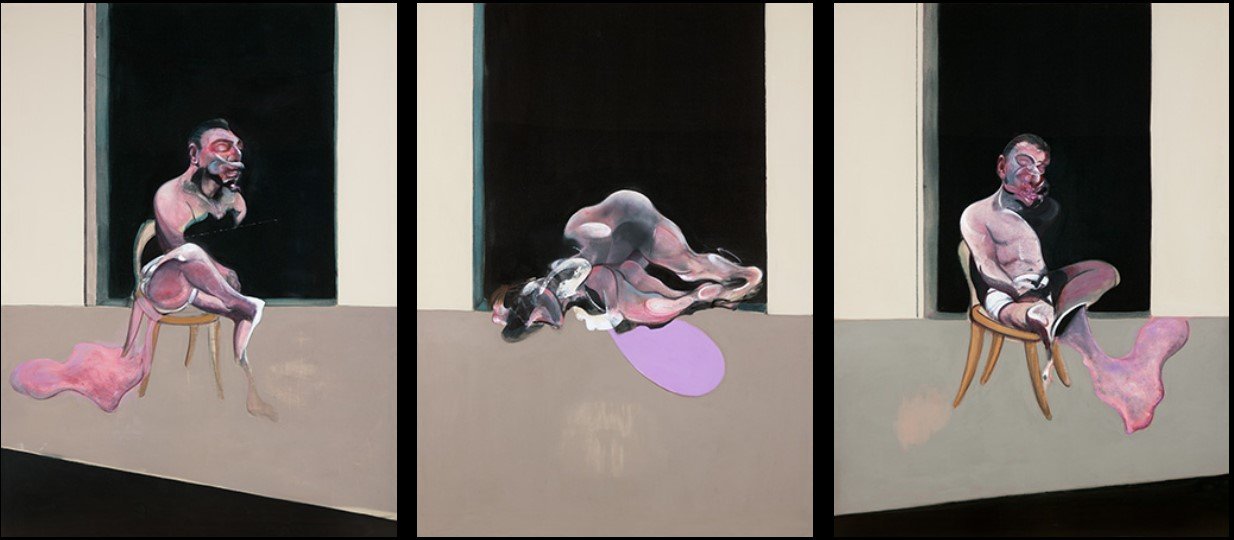
frame 43 September 2023
Bacon and Philosophy: The Art of Transience
by Ben Ware
Ben Ware is the Co-Director of the Centre for Philosophy and the Visual Arts at King’s College, London. He is the author of numerous books on continental philosophy, critical theory, and modernist aesthetics.

Peering into Francis Bacon's oeuvre is a troubling experience.
What are we to make of the mutilated faces, the bulging and contorted bodies, and the large fields of colour which enframe the figures? The paintings are clearly important – each exhibiting a certain sublime aura – but how should we read them? Can these disquieting images even be read at all?
The artist himself had much to say about the ideas behind his image-making. In his famous interviews with the critic David Sylvester, Bacon emphasised that the aim of the paintings was to make a violent impact upon the spectator’s ‘nervous system’. Eliminating what he called the narrative or illustrative aspect of the image, the works seek to ‘unlock sensation’, to provoke a convulsive shudder in those who encounter them.
In an era saturated with explicit and disturbing imagery, however, it is perhaps now time to dispense with the old modernist aesthetic categories of ‘shock’ and ‘sensation’, and to find new ways of approaching Bacon’s art. These new approaches might well begin by paying attention to some of the philosophical and psychoanalytic dimensions of the paintings.
But how to begin moving in this direction?
Triptych, August 1972, Francis Bacon
Bacon is a brilliantly dialectical painter (although he would no doubt have rejected such a label). For him, the essence or truth of a subject is to be found in the distorted recording of its appearance. His gaping mouths, gouged-out eyes and bruised bodies are in no way ‘abstract’, but are, in fact, a way of arriving at the ‘real’ through the ‘artificial’ – a real that is, paradoxically, more real than reality itself.
But what is this real that the paintings (or a great many of them, at least) seek to capture? Nothing less, we might suggest, then the real of transience: what Sigmund Freud describes, in his 1915 essay on the topic, as the fact that all beauty, including human beauty and the beauty of nature, is ‘fated to extinction’.
In the powerful Triptych August 1972, Bacon’s late lover George Dyer is shown to be literally decomposing: his flesh melting into a pool of liquified pinkish-grey matter at the base of the stool on which he is seated. The effect here is not one of shock, the image does not come across violently onto the nervous system; rather, in a subtle and controlled way, the triptych invites us to look the negative (i.e. death) in the face and to tarry with it. Almost all of Bacon’s successful figures appear to have life flowing out of them; and yet strangely, and for the most part, they are able to maintain themselves in this state of devastation. Indeed, their devastation appears to be precisely the source of their strength.
What philosophical lessons, then, might we take from Bacon’s art? Could it be the case that it is only through an encounter with the real of transience that we are reminded of who we really are: bodies made of flesh, tethered to an excess of life, which, in psychoanalytic terms, goes by the name of the drive?
Moreover, might Bacon’s images of subjective destitution bring us, finally, to a new and unexpected threshold: a point from which humanity itself can come to be imagined otherwise?



